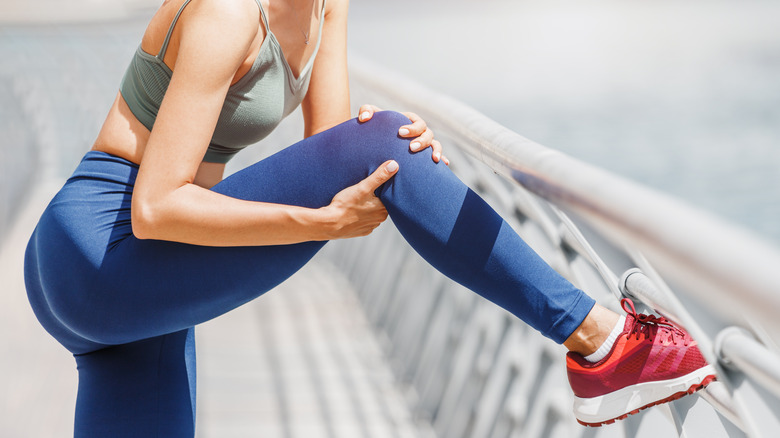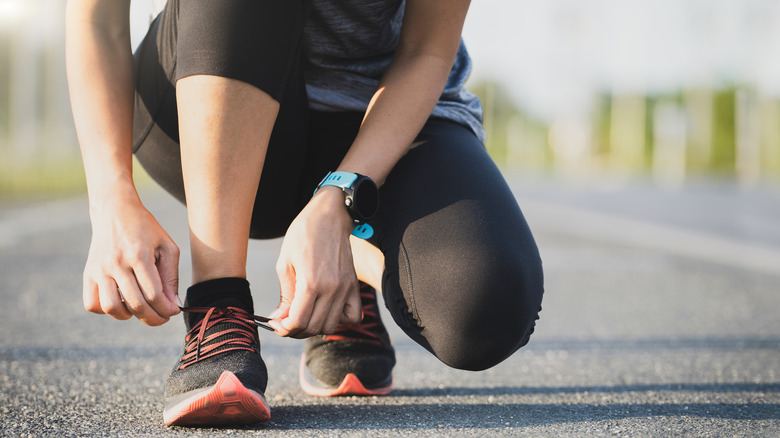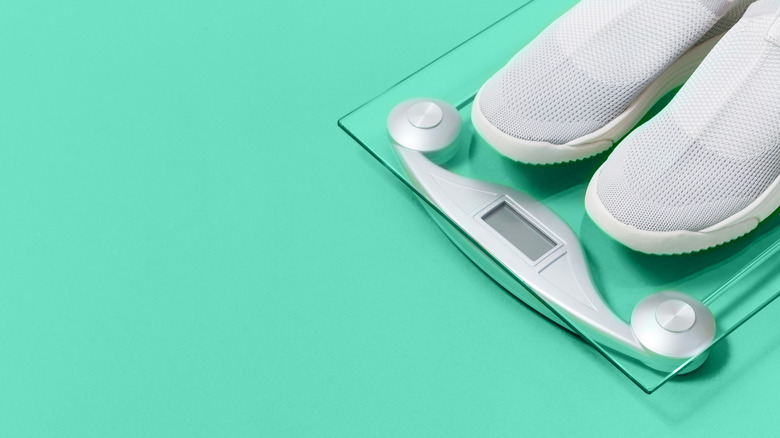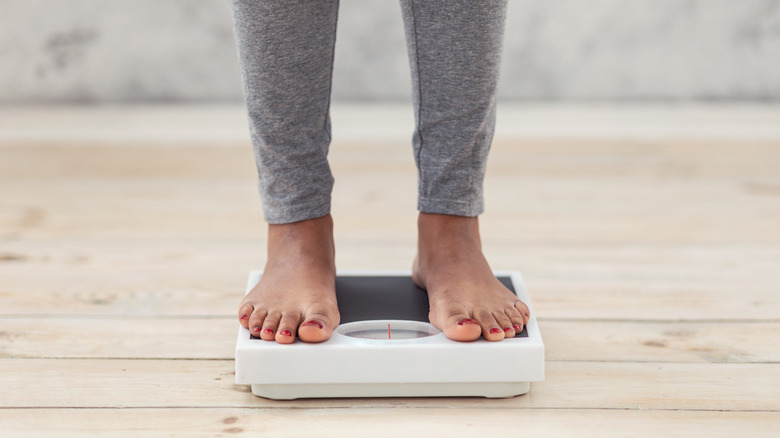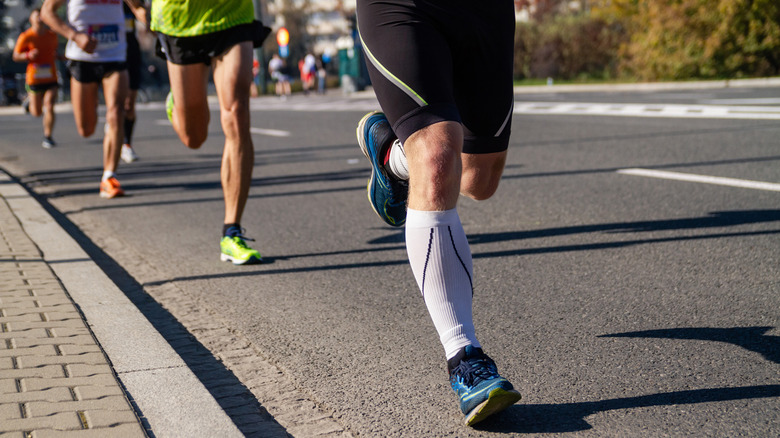Dangers Of Running You Never Expected
We've all heard exercise is good for the body, but is there a chance that not all exercise is good exercise? Running is one of the most common workouts, with over 50 million Americans hitting the asphalt regularly. Scientific studies have shown that even running just 5 to 10 minutes a day decreases your risk of death (via American College of Cardiology).
Running has many benefits, including strengthening muscles, improving cardiovascular health, and supporting mental health. The highly sought-after "runner's high" — when your body releases endorphins during or slightly after running — can give you a sense of peace and calm that helps reduce everyday stress and anxiety levels (via Insider).
However, running is not exempt from the cliché: it is possible to have too much of a good thing. While the pros of running definitely outweigh the cons, there are a few things you should know if you're thinking of seriously taking up the sport, or if you are already an avid runner. Don't let these dangers of running keep you on the couch, but remember them the next time you lace up those running shoes.
Muscle imbalances
While it's true that running helps strengthen your muscles, if it's not paired with other types of workouts, it can lead to muscle imbalances, according to Lafayette General Orthopedic Hospital. Think about it — if you run the same path every day at the park or on a treadmill, going up the same stairs and the same hills, you're going to get a great workout for your butt, thighs, and calves, but your upper body isn't getting much activity.
If you're running regularly, it's important to add cross-training exercises into your routine, like pushups, pull-ups, or weight training, advises the hospital. This will help keep the muscles in your upper body and lower body balanced, which will in turn, help prevent injury. Every part of your body is connected; it's unwise to pay special attention to certain body parts and ignore the others.
Injuries from improper footwear
The next time you put on your running shoes, pay close attention. Do your feet feel comfortable? Have those shoes ever caused chafing or blisters?
Every time you take a step, the shoes you wear cushion the impact. If you're not wearing the right ones, this improper impact can lead to plantar fasciitis, Achilles tendonitis, and pain in your knees, hips, and back, according to the Foot and Ankle Associates of North Carolina.
Finding the best running shoe depends on the runner since the best shoe depends on what foot it's on. In an interview with Insider, Andrew Lemoncello, former Olympian and certified running coach, advised going to a specialty shoe store to get fitted and get advice from a professional. That said, the general recommendation is to get a shoe that is cushioned but not too cushioned, which can inhibit your body's natural movements. You'll also want to get a shoe that matches your specific arch, foot shape, and bone structure.
Your toenails could turn black
You read that right. Black toenails are common among runners wearing the wrong footwear, which is just one more reason to make sure you have the right running shoes for your feet. "When your toenails hit multiple impact points inside the shoe, it can create different points of force — which causes stress on that area," Dr. Bert Mandelbaum, an orthopedic surgeon and sports medicine specialist, told Everyday Health. This can result in bleeding underneath the nails, resulting in black toenails.
This phenomenon can happen not only by running in the wrong shoes but if your toenails are too long, or if you're running too hard or too long. To avoid the unpleasant appearance of black toenails, make sure you are always clipping your toenails before a run and take adequate breaks when running. Also, if you're not sure if you have the best running shoes, visit a specialty shoe store for guidance.
The most common way to run can lead to injury
If you're running the wrong way, you're likely to end up hurting yourself. Proper form varies depending on your specific body type, the type of ground you're running on, and whether you're jogging, sprinting, or training for a marathon. However, it's always wise to maintain good posture, engage your core, and look where you're going (via Healthline). Try to keep a consistent pace and foot strike, landing with a controlled, smooth step every time.
Avoid landing with your heel first, which is commonly called running with a heel strike, since this can cause extra stress on your knees and lead to injury over time. Instead, aim for a midfoot strike, which is landing on the ball of your foot, or a forefoot strike, landing on the ball and toes. The midfoot and forefoot strike helps your body absorb the impact of landing, lessening the chances of injury, according to Healthline.
The next time you go for a run, notice which part of your foot tends to hit the ground first. The majority of runners naturally have a heel strike. If that's you, it will take intention and practice to retrain your body to consistently have a midfoot or forefoot strike, but it is doable.
Increased risk of heart disease
When it comes to running, more may not necessarily be better. According to a study in the Journal of the American College of Cardiology, running extremely long distances, often and fast, is not associated with better health compared with people who do not run. Those who ran over 2.5 hours every week, more than 3 times per week, and at a fast rate did not have increased health benefits compared to sedentary non-joggers. The study also found that marathon runners seemed to have increased risks of heart disease. Another study that compared marathon runners with people who live sedentary lives showed that the marathon participants actually had more coronary plaque buildup, a contributing risk for heart disease, compared to the sedentary folks.
Experts agree that running is good for your health, but too much running might not be. It's important to find a balance, which will vary from person to person. According to current data, running 5 to 19 miles per week at a pace of 6 or 7 miles per hour over three to four evenly spaced days is optimal (via Active).
Heat-related illness
Global warming is bad news for those that enjoy running outside. Running outdoors has many positives — it doesn't require a gym membership and is more financially feasible, and spending more time outdoors can boost mental health. Trail running has increased in popularity over the years. It's easy to see why — especially since running on soft ground like soil or grass provides a more gentle impact on the body (compared to asphalt or a treadmill), which can help prevent injury. Trail running can also contribute to varied movement along your path, especially if you're running along uneven ground with obstacles like rocks, decreasing your chances of developing muscle imbalance from running (via Polar).
However, depending on where you live, running outside can be a challenge, especially in the summer months. And thanks to climate change, the summer months seem to just keep getting longer. Physical activity outdoors in hot temperatures increases the chances of dehydration and heat-related illness, with symptoms like muscle cramps, dizziness, nausea, vomiting, weakness, confusion, and disorientation, as explained by Ready Set Marathon. If you're an outdoor runner, avoid running midday when it's especially hot outside and try to go early in the morning or later at night. And of course, make sure to drink enough water to replace your electrolytes.
Overhydration
Almost everyone knows it's important to hydrate and drink enough water. Some people fear they do not drink enough water, and while dehydration can be a danger of running, it's actually quite common among marathon runners to drink too much water. In fact, overhydrating causes more illnesses in athletes than dehydration, according to MD Alert. This is usually due to excessive running, since the longer or harder you run, the more water you tend to drink.
To avoid this, be sure to sip small amounts of water throughout a run or during the day, instead of downing big gulps. Also, it's wise to avoid painkillers, since they can inhibit kidney function (via Ready Set Marathon). You can also measure the amount of water you consume during your run. Runner's World recommends drinking 1 liter of water for every 1,000 calories you burn. "An average male burns around 2,500kcal a day, a runner covering five miles a day more like 3,000kcal," the publication explained.
Women are especially prone to running injuries
Approximately 79% of runners get injured one way or another and, surprisingly, data suggests that women get injured more often than men, according to Time. This may be because men and women have different body types and structures and as a result, tend to run with different form. Some data also suggests that women are more likely to run with a heel strike, which has been shown to lead to running-related injuries.
Other preliminary research points to the fact that women usually have higher arches and point their toes out as they run, while men usually do not, as Stephen Messier, director of the J.B. Snow Biomechanics Laboratory at Wake Forest University, told Time. However, more research needs to be done to see if this is actually related to increased injury risks. Either way, it's a good idea to do some research on your particular body type and what running form works best for you before taking up the sport.
Overtraining
If you're addicted to that "runner's high" and just can't get enough, make sure to pace yourself. Injuries commonly result from runners doing "too much too soon," Jessica Zarndt, an assistant clinical professor at UCLA David Geffen School of Medicine, told Insider.
Pushing yourself to run for too long or too hard before your body is ready for it is a recipe for disaster. If you try to do too much without the proper training, you're likely to put unnecessary strain on your muscles, leading to overtraining issues and injuries. Slow and steady is the best method in this case.
As Insider highlighted, a study in the Journal of Orthopedic and Sports Physical Therapy showed that runners who increased their weekly distance by more than 30% every week were about 1.5 times more likely to get injured. Increasing the weekly running distance by less than 10% per week proved to be a safer bet. Therefore, a good way to avoid injuries from increasing your running stats is to start with small distances and go at a slow pace, then gradually increase from your starting point. If you don't know where to start, ask your doctor for advice.
Increased appetite and weight gain
Cardio increases appetite, as a study published in Regulatory Peptides demonstrated. Naturally, you're more likely to feel hungry after a run. If you opt for something unhealthy after each run, though, you can miss out on important nutrients and possibly experience weight gain.
Plan your after-workout meal ahead of time so when the munchies hit, you're ready to satiate them with a healthy snack. Avoid keeping unhealthy foods (think: chips, donuts, cookies — anything high in fat or sugar) in easy reach.
Great options for an after-run meal include things high in protein, like eggs, protein shakes, or smoothies with fruit and nut butter. You could also have yogurt with granola, fruits, and nuts, or maybe a salad or raw veggies and hummus (via Healthline). If weight loss is one of your goals for running, go for low-calorie, high-protein, and nutrient-dense foods.
The more you run, the less weight you lose
Running can be an effective form of exercise to burn calories and lose weight, but only to a certain extent. The more you run, the more your body gets used to running and starts to adapt. As your body evolves and adapts, it actually starts to lose fewer calories than when you first started running (via Women's Health). That's why when people first get into running, they usually see some weight loss initially. Over time, though, their progress plateaus, which can lead to disappointment and confusion if you're not expecting it.
If weight loss is your goal, creating a varied running routine will help keep your body guessing and the pounds disappearing. In speaking with Women's Health, Wayne Westcott, fitness research director at Quincy College in Massachusetts, recommended including interval training, which is short, quick periods of intense exercise with moments of recovery time in between. That could mean sprinting for 1 minute, then walking for a few minutes, then jogging for 5 minutes — rinse, repeat. Even simply taking a different running path every day, going trail running instead of road running, or changing the inclines on the treadmill, will help your body disengage "cruise control," according to Westcott.
Long-distance running can actually prevent muscle growth
Over time, running long distances can cause prolonged repetitive contraction of your muscles, according to an article published in the Journal of Physical Therapy Science. Your muscles need time to rest, and without adequate recovery, this can actually prevent muscle gain (via Healthline). Make sure to give yourself enough rest time in between long-distance runs so your muscles can recover. And listen to your body — aches and pains are usually your body's way of telling you that it's time to take a break.
Adequate rest time varies depending on your workout routine and fitness level. "If you're a more experienced runner, one or two rest days should be sufficient for injury prevention and recovery," certified personal trainer Christine Luff explained in an article for Verywell Fit. "As a rule of thumb, limit your total mileage to no more than 40 miles per week to reduce your risk of injury."
Too much oxidative stress
Running too hard or too long can cause a buildup of oxidative stress, which is an imbalance of free radicals and antioxidants in your body (via Active). This can happen during a long, strenuous workout, like running for more than an hour, for example. "Your body is designed to deal with oxidative stress that comes from exercise for the first hour," cardiologist James O'Keefe told Active. "But prolonged intense exercise causes excessive oxidative stress, which basically burns through the antioxidants in your system and predisposes you to problems."
According to Medical News Today, oxidative stress can cause chronic inflammation, which may then lead to cancer, neurodegenerative conditions, and many other serious health conditions. So, even if you love running, this is just one more reason to not go overboard with it. A great way to make sure that your body is able to handle oxidative stress from a workout is to eat a balanced diet high in fruits and vegetables. Consider adding antioxidant-rich foods like fruits, berries, beans, spinach, and kale into your diet if you haven't already (via Healthline).


